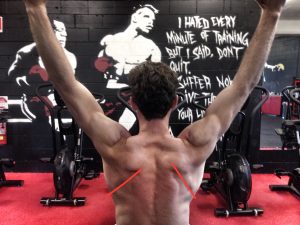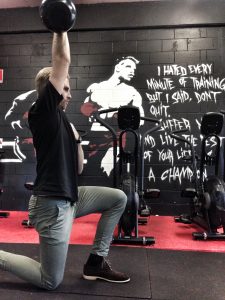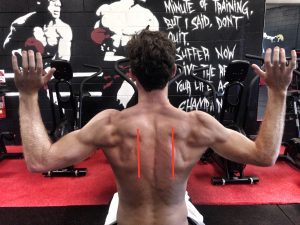To be able to complete activities overhead you need mobility. Are you sick of this word? Do you even understand it? Mobility is essentially comprised of two parts; range of motion and control. It is the useable motion that you have in a joint and can be applied to any joint throughout your body. Now the control component partly comes from the stability. Sick of the word? Do you understand what it means? Its the combination of physical structures and muscle activation. The bony structure is the shape of the joint such as the shallow cup of the scapula which enables the ball shaped head of the humeral head to sit in it. This is complimented with your ability to activate a muscle in a designated pattern. These two components provide a solid base of support and can be simply known as stability. In the shoulder this largely comes from the control of the Scapula (shoulder blade). Lack of this is known as Scapular Dyskinesis.

Decreased upward rotation of the right scapula… WHY??
So what do I need to check before I can get my licence?
-lat length
-anterior core control (keeping the rib cage down)
-scapular control to move the scapular on the rib cage
-rotator cuff control to centrate the humeral head in the glenoid throughout abduction/ flexion
-thoracic extension to prevent either forward head posture or lumbar extension
So just do a bunch of foam rolling, add in some seated rows, squeeze your shoulder blades together and you should be sweet…..???
NO! There is almost no sport or activity that requires the scapula to be stabilised in a single position, it needs to be stable in multiple dynamic positions. This requires the scapula to be controlled against the rib cage while the arm moves from a neutral position all the way up to full flexion or abduction. If we anchor it in the one position we will be in turn limiting our range of motion.
Another area where injuries can raise their ugly head in overhead movements is when there are disparities between Left and Right limbs. This can become problematic when doing fixed motions such as machine presses or barbell presses where the body (particularly the spine) will have to compensate for an abduction/ flexion ROM loss on that side.
This spinal compensation is excessive lumbar extension (arching), This can be cued by making sure you aren’t swaying your hips forward when going overhead.
So once I’ve worked on my mobility and stability within my shoulder what’s a safe overhead training exercise?
Well without giving away all our secrets, a nice little exercise is a half kneeling kettlebell shoulder press. The half kneeling position allows a safer lumbopelvic position and the kettlebell allows the exercise to be done unilaterally. The focus of this exercise is to control the kettllebell while externally rotating the shoulder to decrease chance of repeated subacromial impingement.
Disclaimer
Overhead movements can be quite complex therefore it is hard to provide an in depth assessment protocol for going overhead in a written format. This material is not designed to be a one size fits all approach and this article is aimed to get you thinking about whether or not there might be some things that need addressing before you start throwing weights around or even if you’re competing in sports that require repetitive overhead activity such as tennis or cricket.[/fusion_builder_column][/fusion_builder_row][/fusion_builder_container]

